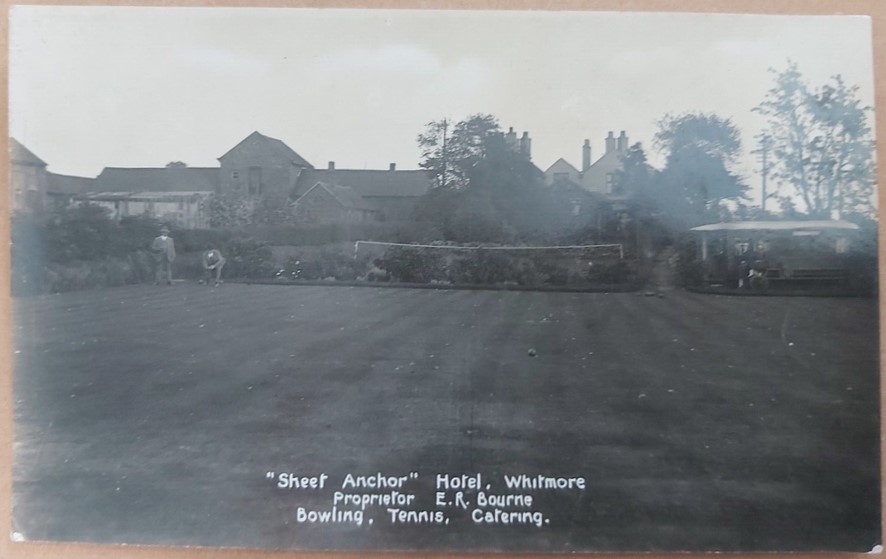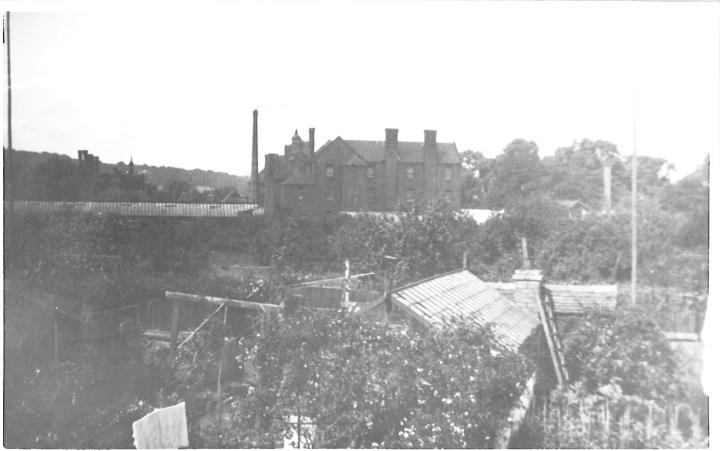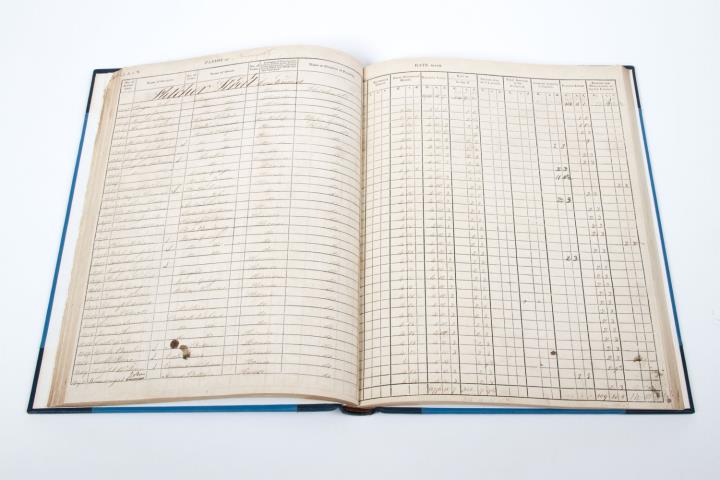The Independent Order of Oddfellows Manchester Unity Friendly Society was a non-profit, mutual insurance, fraternal order founded in Manchester in 1810. Members’ benefits included health, medical, and funeral insurance and other forms of mutual assistance.
In 1841 a branch of this Oddfellows lodge called the ‘Hope and Anchor Lodge’ was established in Whitmore. Its meetings, hosted by the publican Andrew Martin and accompanied by lavish dinners, were held at the Mainwaring Arms.
The Staffordshire Advertiser 9 October 1841
INDEPENDENT ORDER OF ODD FELLOWS, M.U.
THE OPENING of the LOYAL HOPE AND ANCHOR LODGE, NO. Pottery and Newcastle District, will take place at 3 o'clock on Tuesday, the 19th instant, at the house of Host Andrew Martin, MAINWARING'S ARMS INN, WHITMORE, when the attendance of any Brother will be esteemed a favour.
Staffordshire Advertiser 25 October 1851
ODD FELLOWSHIP.-On Tuesday last, the officers and members of the Hope and Anchor Lodge of Odd Fellows, Manchester Unity, held at the Mainwaring Arms Inn, Whitmore, celebrated their tenth anniversary, and the legalization of the order. At four o'clock the members sat down to an excellent dinner, provided by the worthy host, Mr. Andrew Martin. The usual loyal and other toasts were drank. Mr. Bates, in responding to "Prosperity to the Hope and Anchor Lodge," stated that the number of members was about sixty, most of them under twenty-five years of age, and that the lodge had an accumulated capital of £150 as a reserve fund, and was, moreover, rapidly increasing the number of members.
The Staffordshire Advertiser 2 March 1861
HOPE AND ANCHOR LODGE OF ODD FELLOWS, MANCHESTER UNITY.-The Rev. Mr. SILVER, of Norton-in-Hales, has kindly consented to deliver a LECTURE for the Benefit of the Widows' and Orphans' Fund connected with the Lodge held at WHITMORE, at the SCHOOL- ROOM, MAER, on Thursday evening, the 7th of March, 1861; subject, “NEW ZEALAND,” illustrated with Dioramic Views. The Rev. Mr. TAYLOR will preside. On Thursday evening, March 14th, the Rev. Mr. Silver will deliver a LECTURE at WHITMORE; subject-"THE IRON HORSE; ITS PEDIGREE AND PERFORMANCES." The Rev. C. H. MAINWARING will preside.
The lectures will commence at seven o'clock each evening. A collection will be made at the door on each occasion in aid of the object above named.
The Staffordshire Advertiser 29 September 1866
ODDFELLOWSHIP AT WHITMORE-On Tuesday last the members of the Loyal Hope and Anchor Lodge (No. 2,963, M. U.) formed a procession, which, headed by the Newcastle Volunteer band, marched through several villages to the old Parish Church, Whitmore, where an excellent and appropriate sermon was preached by the Rev. C. H. Mainwaring. An excellent dinner was afterwards served up by Mr. and Miss Martin, at the Mainwaring Arms Inn. The Rev. C. H. Mainwaring presided. The lodge now numbers 120 members.
There are several lodges in Staffordshire named the Hope and Anchor Lodge. I am not certain that the following case concerns the lodge associated with Whitmore. However, it makes interesting reading for the rule concerning the age of entry and also of the benfits gained from belonging to the organisation.
The Staffordshire Advertiser 9 November 1867
COUNTY COURTS.
LICHFIELD.-MONDAY.
(Before W. Spooner. Esq., Judge.)
A FRIENDLY SOCIETY CASE-JOHN KELLY v. JOHN FLETCHER, JAMES WHITE, AND THOS, BASSETT -This was an action brought by the plaintiff to recover from the defendants, as trustees of the Hope and Anchor Lodge of the Grand United Order of Odd Fellows, the sum of £5 18s. 8d.. money which he had paid to the lodge as fortnightly subscriptions, entrance fee, &c.-Mr. Simpson appeared for the plaintiff, and Mr. Wilson for the defendants-Mr. Simpson stated that the plaintiff sought to recover back the money on the ground that the consideration had wholly failed. He found that owing to his having entered the lodge when he was more than 40 years of age he was not legally a member, and this objection would certainly be raised in the event of his claiming old age pay or any other benefit.-His Honour stated that in a similar case he had given judgment against a society on the ground that the consideration having wholly failed the plaintiff was entitled to recover back the money.-Mr. Wilson said he should require strict legal proof on every point, the case being one of considerable importance to the society. The plaintiff was then called, and deposed that he entered the lodge in 1862, when he was in his 42nd year. The rules stated that no person above 40 should be admitted as a member, but he was told at the lodge that persons above that age might be taken in case the ages of all the members did not average more than 40. He paid his entrance fee and the fortnightly subscriptions, which he now sought to recover. He was 48 years old.-Mr. Wilson contended that the plaintiff could not prove his own age.-Mr. Simpson, however, urged that, in the absence of evidence to the contrary, his own evidence on this point must be taken for what it was worth, and asked him whether he could remember any events in his childhood which would help him to fix his age.-The plaintiff stated that his father was in the 19th Foot, and that he himself was born in 1819. In 1824, when he was five years old, the regiment was at Sligo, and his father told him to fill a kettle for tea. He went down to the seaside and got the water there, for which bis father gave him a good thrashing, which he had remembered ever since. (Laughter.) He also remembered a man being flogged there, and recollected being in Barbadoes in 1828-The Judge said this was sufficient evidence of age in the absence of proof to the contrary.-The plaintiff added that before he joined the lodge he told the host and others that he was more than 40.-On Mr. Wilson raising another technical objection, his Honour observed: Mr. Wilson throws all the difficulties he can in our way: we must see whether we cannot get over them one by one.--Mr. Wilson afterwards suggested that the plaintiff's only reason for bringing this action was that the society was in difficulties, and that he wished to obtain an advantage over the other members by receiving back all the money he had paid.-Mr. Simpson said he was not aware when he came into Court that the society was otherwise than in a prosperous state Mr. Wilson having objected that there was no evidence that the defendants were trustees, or had dealt with the society's funds, his Honour told the defendant White to get into the witness-box. White did so, and stated that he was appointed one of the trustees of the society in September, 1867, that Fletcher and Bassett had acted with him as trustees, and that they had drawn money out of the bank on account of the society. The amount they had drawn out was £82 7s. 6d., the greater part of which they had paid away.-His Honour reserved judgment until the next Court, and a similar course was taken with regard to another action of the same kind against the same defendants.
In December the case was found against the plaintiff (Kelly).
In the 1880s the Hope and Anchor Lodge held meetings, picnics, and dinners at the Sheet Anchor Inn.
Staffordshire Advertiser 8 July 1882
PIC-NIC in connection with the HOPE and ANCHOR LODGE of ODD FELLOWS will be held on the BOWLING GREEN, SHEET ANCHOR HOTEL, WHITMORE, on THURSDAY, August 10, 1882 Particulars in a future Advertisement.
Newcastle Guardian and Silverdale, Chesterton and Audley Chronicle 12 August 1882
FETE AT WHITMORE.-The second fête of the season was held on Thursday, on the pleasant green at the Sheet Anchor Hotel. It need scarcely be said that every attention was paid to visitors to promote their enjoyment. The Crewe Steam Shed Brass Band was engaged for the dancing.
Newcastle Guardian and Silverdale, Chesterton and Audley Chronicle 12 June 1886
WHITMORE. ANNIVERSARY.-The Loyal Hope and Anchor Lodge of Oddfellows held their anniversary on Thursday. After attending divine service at the Parish Church, where an excellent sermon was preached by the Rector (Rev. P. E. Mainwaring), the members walked to the Sheet Anchor Hotel, for dinner. The lodge has now a capital of £3,000, and during the past year it has saved upwards of £100, which was considered most satisfactory. The membership is now 160, nine new members having entered on Thursday. The evening was spent in an agreeable fashion.
Newcastle Guardian and Silverdale, Chesterton and Audley Chronicle 19 June 1886
WHITMORE.
ODDFELLOWS' FETE. The anniversary of the Loyal Hope and Anchor Lodge of the Manchester Unity of Oddfellows was celebrated on the 10th inst., at the Sheet Anchor Hotel. There was a good gathering; and the celebration included the usual incidentals-a procession, attendance at Divine service, dinner, and general festivities, a distinctive and most enjoyable feature being dancing on the Green to the inspiring strains of the Stone Military Band.
The Whitmore Lodge was still active in the early twentieth century.
Staffordshire Sentinel 11 July 1904
WRINEHILL DISTRICT ODDFELLOWS.
PRESENTATION TO A SILVERDALE VETERAN.
The half-yearly meeting of the Wrinehill district of the Manchester Unity Oddfellows was held at the Sheer Anchor Hotel, Whitmore, on Saturday, when there was a full muster of officers and delegates, under the presidency of Bro. Fredk. Burgess, Prov. G.M. Audley).
After the Prov. Grand Master's address, the meeting passed a vote of condolence with the widow of Bro. James Beech (Alsagers Bank), who died recently during his term of office as Prov. D.G.M. The meeting voted £10 to the bereaved widow and family.-Bro. C. H. Durber (Silverdale) was elected Prov. D.G.M.
Following the business meeting-which will be reported in "Friendly Society Jottings in the "Weekly Sentinel' on Saturday (particularly with reference to a somewhat disquieting report from the lodge book examiners in regard to the excessive sickness experience of the district), the officers of the Hope and Anchor Lodge entertained the delegates to a substantial meat tea, which was greatly enjoyed.
After the spread, the district made two interesting presentations of certificates recognising services rendered-one to Past Grand William Webb, of Silverdale, and the other to Bro. Jos. Inskeep, secretary of the Diamond Jubilee lodge, Madeley. Bro. Webb was made an Oddfellow in June, 1851, at Newport, Salop; he was transferred to the Good Samaritan lodge, Silverdale, 38 years ago, and has been treasurer of that lodge for 32 years. He was made district treasurer in 1876, and resigned at Whitmore 14 years ago.
In 1915 David Keen Johnstone, a former member of the Oddfellows, was buried at Whitmore. The report of the funeral mentioned:
A little way before the Whitmore Church the procession was met by members of the Loyal Hope and Anchor Lodge of Oddfellows, in which the late Mr. Johnson filled many offices. The representatives included Bro. Bm. Randles, N.G., Bro. A. T. Goodall, is secretary, P.P.G.M. Bernard Robertson, Bros. F. W. Arkinstall and Wm. Talbot (trustees), and about 20 other members, including Bros. J. W. Cheadle, A. Hampton, H. Talbot, J. Shemilt, C. Bowers, J. Talbot, J. Harding, S. Smith, A. Harding, Henry Talbot, Harry Talbot, Thos. Picken, G. Podmore, W. Butters, and H. Cliffe.
I am not sure how long the Hope and Anchor Lodge continued. Its activities were still being reported in 1927.
In the 20th century, the welfare state and the National Health Service took over the role of friendly societies Since 1948 the Oddfellows has evolved in other directions, with a continuing focus on the social
involvement, care and support, as well as financial benefits. In the second half of the 20th century, the Oddfellows moved into financial products; in 1991, the Independent Order of Oddfellows Manchester Unity founded the Manchester Unity Credit Union Limited, a savings and loans co-operative established for members of the order.
Related posts
Wikitree – some members of the Hope and Anchor Lodge:































